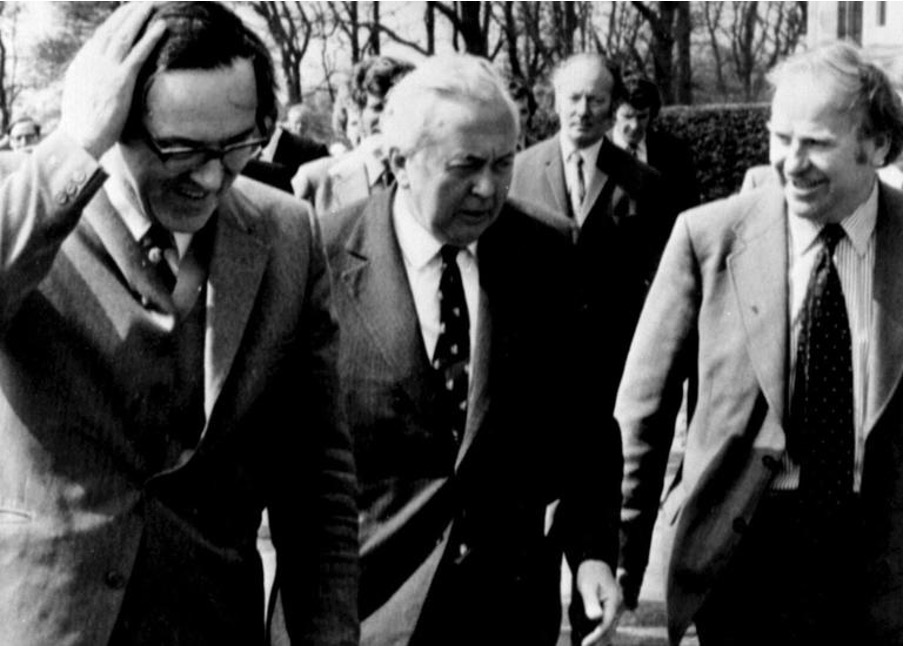
Declassified files detail the British government’s secret meetings with loyalist paramilitary group The Ulster Volunteer Force (UVF) in 1974, and the political support afforded the organisation during its ongoing campaign of violence.
Meetings would occur both at the home of the Northern Ireland Office (NIO), Stormont Castle, and a secluded government owned property known as Laneside. The latter address would also play host to government meetings with the Irish Republican Army (IRA) during the 1970’s.
Through the process of meetings, the UVF, who wished Northern Ireland to remain part of the United Kingdom, were de-proscribed as a banned terrorist organisation on 23rd May, along with Irish republican group, Sinn Féin. This meant that membership of the UVF alone was no longer a prosecutable offence. The order was brought forth by a newly formed Labour minority government, who ostensibly wished to see the UVF move into the political process and away from violence.
However, documents indicate that senior UVF members meeting with officials were also those suspected of participation in UVF bomb attacks in Dublin and Monaghan the same month, in which security forces are also alleged to have been involved. The bombings, which killed 34 civilians, represented the greatest loss of life in one single incident during the three decades of the conflict and commemorate the 50th year since their passing on 17th May.
The attacks were part of wider unionist agitations that year against the Sunningdale Agreement, which in December 1973 established a Northern Ireland Assembly and power-sharing Executive between Ulster unionists and Irish nationalists. The agreement also established a Council of Ireland, that allowed Dublin a degree of oversight of Northern Ireland’s affairs – something the UVF and most unionist groups opposed vehemently.
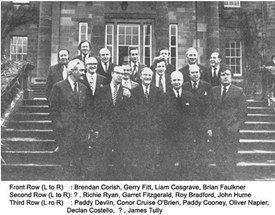
The files reveal that when the government’s efforts to politicise the UVF hit obstacles related to their conflicting views over the Sunningdale Agreement, their focus instead turned to sowing discord amongst unionist political groups and loyalist paramilitaries.
Furthermore, recently declassified material demonstrates that through this relationship the UVF were to seek and gain benefits and conveniences from the government and security forces not typically afforded to political or paramilitary groups.
Bombs in Dublin and Monaghan
The files document that the UVF’s key representative throughout meetings with government officials was Ken Gibson, who in 1974 served as the UVF’s Chief of Staff. Another member of UVF Brigade Staff present at early meetings was William Mitchell, who also edited the UVF’s magazine, Combat.
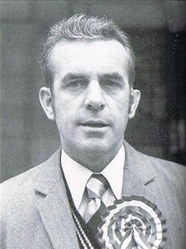
During the 1990’s, investigative journalist Joe Tiernan conducted a series of interviews with Mitchell, who is understood to have disclosed his previous involvement in attacks and the UVF’s relationship with British military intelligence. Tiernan has asserted that both Gibson and Mitchell were part of a UVF unit responsible for bomb attacks in Dublin in December 1972 and January 1973, which killed three people and left 133 more injured.
Further maintained by Tiernan, is that this UVF squad were directed in the attacks by British intelligence officers operating out of the British Army HQ in Lisburn.
Tiernan has also upheld that on the morning of 17th May 1974, Mitchell and an unnamed UVF commander stole a blue Ford Escort in Belfast, before delivering it to a car park on the northern outskirts of Dublin.
The car was then loaded with a bomb and driven into Dublin city centre, where Mitchell and his accomplice were identified in the Escort by a witness. The car would then be parked on Talbot Street, where at approximately 5:30pm, during rush hour, it would detonate without warning, killing 14 civilians.
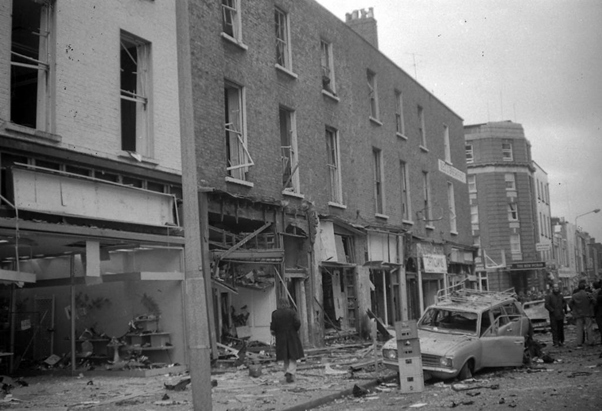
Two additional car bombs would also detonate near simultaneously on Dublin’s Parnell Street and South Leinster Street, killing 12 more civilians. A final bomb would explode 90 minutes later in the border town of Monaghan, killing seven people.
The UVF would only claim responsibility for the attacks in 1993, following an investigation by Yorkshire Television that same year, and in which Tiernan himself was a key researcher. This documentary traced and named a number of the UVF members alleged to have been involved in the operation, yet to date nobody has been charged for the atrocities.
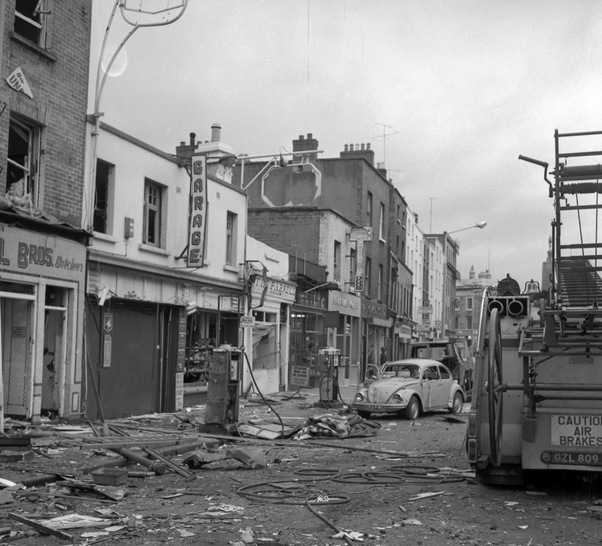
An inquiry into the attacks by Irish judge Henry Barron, concluded in 2003 that they were a “reaction to the Sunningdale Agreement” and carried out by UVF members from Belfast, Portadown and Lurgan. He added that they were “likely” to have been “conceived and planned in Belfast,” where Gibson held the UVF’s most senior rank. Tiernan has also upheld that Mitchell played a key role in the operation’s planning, given his previous experience in bombing Dublin in the years prior.
Collusion
Former Special Patrol Group Officer from the police service of Northern Ireland – then known as The Royal Ulster Constabulary (RUC) – John Weir, gave evidence to Barron’s inquiry. Weir has alleged that in the mid-1970’s he was part of a rogue gang of UVF members, RUC officers and soldiers from the British Army’s Ulster Defence Regiment (UDR).
Based at Glenanne Farm in County Armagh, Weir claimed the gang were responsible for numerous sectarian attacks and murders throughout the 1970’s, including the Dublin and Monaghan bombings. Their activities were apparently given tacit approval by senior RUC officers.
Weir and other sources have named Mid-Ulster UVF founder Billy Hanna, as the main organiser of the Dublin and Monaghan bombings. Through interviews with Hanna’s family, Tiernan has revealed that Hanna was regularly visited at his home by British intelligence officers. He alleges these officers were to give Hanna his orders, who, after consultation with UVF Brigade Staff HQ in Belfast, was to assemble his team for the operation.
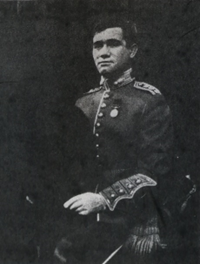
Barron’s inquiry and Yorkshire Television’s investigation both also noted the relationship between UVF suspects and officers from the army’s Special Air Service (SAS) proxy group, 14 Intelligence Company, most notably, Robert Nairac. In addition to running UVF suspects as agents, Nairac is also alleged to have been involved in the supply of weapons and planning of attacks.
Former British intelligence officer Fred Holroyd, has explained that in 1974 “loyalist explosive capability was pretty limited” and predominantly utilised “beer kegs filled with explosives with a black powder fuse.”
The Dublin bombs, however, were a drastic departure from these methods, and utilised sophisticated timing devices to synchronise the detonations of the three car bombs. Forensics also noted that all the explosives used detonated completely, leaving no residue to trace.
Former British army bomb disposal expert Lt Col George Styles, has too raised this peculiarity, to which he stated: “I had no high regard of their [UVF] skill in 1974, I don’t think they were at a level that would equate to the sort of techniques that were used here in Dublin.” The UVF categorically denied involvement of British state security services.
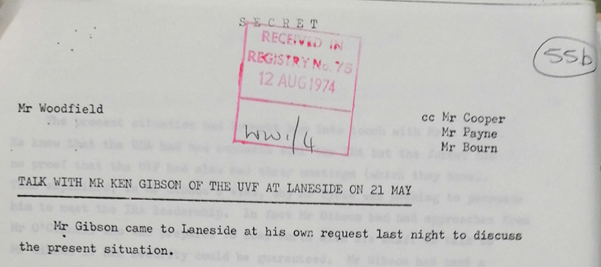
Only four days after the attacks, Gibson would meet deputy under-secretary Phillip Woodfield, in a meeting in which it was recorded that “the UVF remained firmly against violence.” The UVF would be officially de-proscribed the same week.
Whilst the UVF did not claim responsibility for the bombings in their immediate aftermath, there were some early media reports pointing toward the involvement of loyalist paramilitaries. Curiously, the documents record no mention or questioning of the UVF on these attacks by government officials in meetings.
“Political Feet”
On 9th April, files record that Minister of State for Northern Ireland Stanley Orme, met at Stormont Castle with a UVF deputation which included Gibson and Mitchell. Also present was a member of the UVF’s “welfare section” Hugh Smyth, who held a seat in the Assembly as an independent.
The record noted that Orme expressed his belief in the importance of the UVF’s dialogue with the government in helping “working class protestants to find their own political feet.” He added that “at the next election there was no reason why the UVF might not have a number of members elected to the Assembly and indeed why they might not be a member of the Executive.”
Smyth explained that “they [the UVF] were against the Assembly because it had been imposed on them,” but that he recognised its “practical necessity” as “the only forum in which he could represent the views of his constituents.”
On 15th May, the Ulster Workers’ Council (UWC) strike began, organised by unionists opposed to power-sharing and the Sunningdale Agreement’s Council of Ireland proposals. The strike caused widespread disruption to Northern Ireland’s economy, with electricity and fuel supplies amongst seriously affected sectors. Throughout the strike, loyalist paramilitaries, including the UVF, engaged in campaigns of intimidation and manned roadblocks to ensure workers were unable to work.
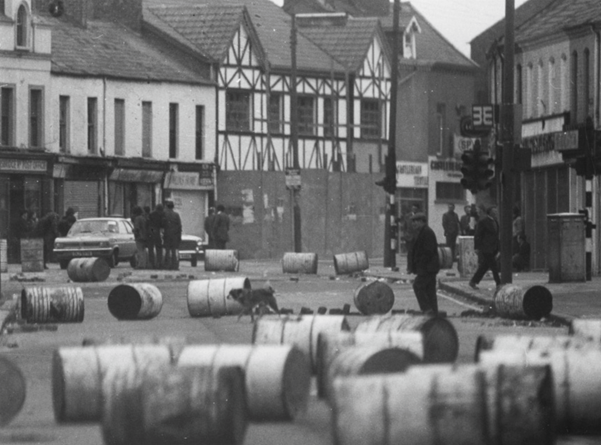
Secretary of State for Northern Ireland Merlyn Rees, said he would not negotiate with the UWC, but officials including Orme would continue to meet with Gibson, who was the UVF’s representative on the UWC coordinating committee.
At the end of the month, diplomat and Counsellor to the NIO, James Allan, recorded a meeting at Laneside, also attend by MI6 agent Michael Oatley and a UVF deputation.
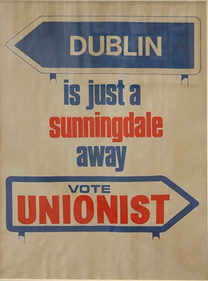
Allan recorded that the UVF’s objective was to “reduce the influence of the UUUC [United Ulster Unionist Council],” a body that sought to unite unionists opposed to the Sunningdale Agreement. This was apparently due to the UVF’s belief that the UUUC were “using the strike for their own purposes,” and were “not representative of working-class opinion.”
Allan noted that it was “not clear whether they [UVF] would accept the continuance of the power-sharing Executive,” but that “they were definitely against the Sunningdale Council of Ireland proposals.”
At this juncture, Allan noted that the government’s relationship with the UVF had “become very strange,” as they were “desperately in need of advice” on securing “UVF participation in politics,” but also held a fundamentally conflicting political position to the government on Sunningdale.
Consequently, he concluded that “thought should be given as to how to profit” from the relationship, in a way that would give the government the “most direct entre to the UWC.” He added that “it may be that it can only be used for fuelling possible dissention between UUUC politicians and para-military organisations.”
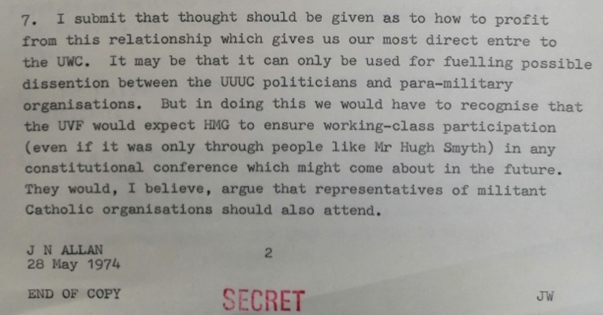
The following day, pro-power-sharing Ulster Unionist Party politician Brian Faulkner, resigned as Chief Executive of the power-sharing executive. This was due to Rees’ refusal to meet UWC representatives, and Faulkner’s loss of support from unionist voters. Consequently, the power-sharing Executive and Assembly collapsed, at which point direct rule from London was resumed.
An Offer of Services
While government officials ostensibly wished to see the UVF politicise through de-proscription, there is indication that the UVF themselves may have had different ideas about their nearing legalisation and newfound relationship with the government.
Documents show that on 30th April, Allan received a letter addressed to the Secretary of State from a UVF “adjutant” named William Johnston. In it, Johnston stated that: “Brigade Staff hereby offer the services of the UVF and its associate Units to supplement the Civil and Military Authorities in their endeavours to combat terrorism and anarchy.”
In aim of “building better relations between ordinary people and the Security Forces, UVF observers could be attached to regular army and RUC patrols,” he added.

Johnston acknowledged that such a move could “be seen to be a collusion between the government and a supposed terrorist organisation,” but that UVF personnel “would at all times be subject to Government law and discipline.”
Interestingly, in the record of a meeting just two weeks later, Allan noted that a UVF deputation showed no knowledge that this communication had been issued.
Release of Detainees
Under de-proscription, UVF deputations would press government officials for the release of detainees stated to be “moderates” with “political abilities,” who were considered vital to their political efforts.
In a meeting record from 15th May, Orme’s Private Secretary Mr Finlayson, noted Gibson’s concern of a “shortage of political spokesmen for the UVF,” and assertion that a number of imprisoned UVF members would be able to fulfil this role. Orme assured the deputation that the issue was under “urgent consideration” by the government.

Gibson stressed that “particularly important to them” was the release of Billy Davidson. Once released, Davidson would become Co-Chairman of the UVF’s short lived Volunteer Political Party, before becoming involved with the Northern Ireland Negotiated Independence Association in the late 1970’s. Hugh Smyth would also further his political career, leading the Progressive Unionist Party from 1979-2002.
However, documents also indicate that under de-proscription the UVF would request the release of detainees held on more serious charges, and who seemingly had no political inclination. A meeting record from 1st August noted that a UVF deputation including Gibson, expressed a need “to get responsible (and strong) men released”, so “they could get their areas under control.”
One notable request for release on the provided list was for “Leonard Murphy,” which the document noted as “sentenced.” At the time, Murphy was serving a sentence for attempted prison breaks that occurred during his time detained awaiting trial for the murder of a protestant man named William Pavis in 1972. This murder was allegedly ordered by the UVF, who believed Pavis was selling guns to the IRA.
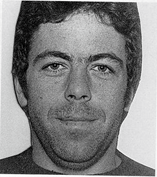
Murphy was eventually acquitted of the murder charge on grounds of contaminated evidence, despite being identified as Pavis’ killer by two witnesses.
Following his release from prison in May 1975, Murphy would go onto become leader of a UVF gang known as the Shankill Butchers. Under Murphy’s leadership and with his active involvement, the gang would murder seven catholic civilians over the course of the next year. Three of the six murders carried out by Murphy personally, would involve extreme violence, torture and throat slashings being inflicted upon innocent victims.
Murphy was rearrested in March 1976 and sentenced on firearms charges following his attempted murder of a catholic woman, but continued to advocate for, and direct further murders from prison.
Days after his release from prison in July 1982, Murphy would continue to kill. He claimed another three victims before being murdered by IRA gunmen in November, in a hit that was allegedly facilitated by a UVF tip-off.
“Low Level Protection”
Another feature of meetings were requests by the UVF that security force pressures on their organisation be curtailed, and even “personal protection” be offered to UVF leaders. In a meeting record from mid-May, a UVF deputation lamented that their members were “continuously harassed” by British parachute regiment, 3 Para. Smyth added that they were “particularly concerned about army searches early in the morning,” which meant “people were detained in their house until the searches finished,” often making them late for work.
The record noted that Orme said he would soon be visiting 3 Para to “investigate the matter,” and would be “discussing with the Security Forces the times at which searches were carried out.”
Another meeting record from the end of May, a UVF deputation led by Gibson was recorded by Allan to be “clearly worried that their position may be undermined by arrest of UVF leaders.” Allan resultantly noted that the government “should think very carefully before action is taken vis-a-vis UVF politicals,” and that he would be “grateful to have the opportunity to comment on possible arrest lists.”

In late 1974, a feud also began between the UVF and another loyalist paramilitary group the Ulster Defence Association (UDA). On 18th March 1975, John McKeague of Red Hand Commando (a UVF affiliated proscribed paramilitary organisation) and loyalist activist Sam McClure are recorded as having visited Laneside, where they were met by deputy Under Secretary of State John Bourn.
Documents note that McKeague and McClure requested “low level protection” for themselves and two other loyalist paramilitary leaders, one of which was Gibson. They suggested that if they as “politically inclined leaders” were to be assassinated, a “blood bath” would ensue.
The author of the meeting record, noted as “BM Webster,” stated that it would be “unwise” to raise the issue with the RUC, who were against giving special protection to paramilitary leaders. He noted, however, that they “could put the matter to the army” but would “have to be careful” in how they approach the subject.
Re-proscription
In June of that year, the UVF would establish the Volunteer Political Party (VPP). Gibson as Chairman would go on to contest the West Belfast seat in the October 1974 general election, but would win only 6% of the total votes in this constituency.
The party was dissolved only a month later, with a VPP statement acknowledging that the “general public does not support the political involvement of the UVF.” Most VPP members would return to the UVF, who would issue a new policy document asserting “attack as the best means of defence.”
On 2nd October 1975, the UVF would launch a series of gun and bomb attacks across Northern Ireland that left 12 dead. Documents record that in meetings between government officials the following day, it was accepted that the UVF were “wedded to violence” and “sufficiently offensive” as to warrant re-proscription. Rees would sign the order into effect the same day, making the UVF a banned organisation once again.
Many deadly UVF attacks that occurred throughout the conflict in Northern Ireland remain embroiled in controversy over security force collusion. The British government has previously refused to disclose important files it holds relating to many incidents, including the Dublin and Monaghan bombings, something emphasised in Barron’s 2003 inquiry. Consequently, civil action was taken against the British Ministry of Defence and NIO by victims and families at the High Court in Belfast in 2014.
Organisations such as Justice for the Forgotten, The Pat Finucane Centre and Paper Trail, amongst others, have campaigned in support of victims’ families throughout these processes, and continue to work in quest of the truth behind many attacks. A new inquiry into the activities of the Mid-Ulster UVF and their relationship with security forces during the 1970’s, named Operation Denton, is currently ongoing.

However, the British government’s Northern Ireland Troubles (Legacy and Reconciliation) Bill now looks to shut down avenues of legal recourse for survivors and victims’ families seeking justice.
Since 1st May 2024, all Troubles-era cases not yet concluded have been transferred to a new body, and new cases will be prevented from being lodged in court. The bill, which has been opposed by all political parties in Northern Ireland, also provides immunity from prosecution for those coming forward and giving evidence.
Questions remain on whether elements of the British intelligence community sought to subvert the Sunningdale Agreement by working with the UVF, and the degree to which government officials were aware of intelligence relating to alleged collusion. Nevertheless, the British government’s and UVF’s conflicting ulterior motives resulted in a confused political relationship, which failed in efforts to politicise militant loyalism or win over working-class unionist voters to power-sharing. The freedom of operation afforded the UVF by de-proscription also arguably facilitated its regrouping as a paramilitary organisation, and emboldened the group in its violent efforts to undermine government policy.

CovertAction Magazine is made possible by subscriptions, orders and donations from readers like you.
Blow the Whistle on U.S. Imperialism
Click the whistle and donate
When you donate to CovertAction Magazine, you are supporting investigative journalism. Your contributions go directly to supporting the development, production, editing, and dissemination of the Magazine.
CovertAction Magazine does not receive corporate or government sponsorship. Yet, we hold a steadfast commitment to providing compensation for writers, editorial and technical support. Your support helps facilitate this compensation as well as increase the caliber of this work.
Please make a donation by clicking on the donate logo above and enter the amount and your credit or debit card information.
CovertAction Institute, Inc. (CAI) is a 501(c)(3) non-profit organization and your gift is tax-deductible for federal income purposes. CAI’s tax-exempt ID number is 87-2461683.
We sincerely thank you for your support.
Disclaimer: The contents of this article are the sole responsibility of the author(s). CovertAction Institute, Inc. (CAI), including its Board of Directors (BD), Editorial Board (EB), Advisory Board (AB), staff, volunteers and its projects (including CovertAction Magazine) are not responsible for any inaccurate or incorrect statement in this article. This article also does not necessarily represent the views the BD, the EB, the AB, staff, volunteers, or any members of its projects.
Differing viewpoints: CAM publishes articles with differing viewpoints in an effort to nurture vibrant debate and thoughtful critical analysis. Feel free to comment on the articles in the comment section and/or send your letters to the Editors, which we will publish in the Letters column.
Copyrighted Material: This web site may contain copyrighted material the use of which has not always been specifically authorized by the copyright owner. As a not-for-profit charitable organization incorporated in the State of New York, we are making such material available in an effort to advance the understanding of humanity’s problems and hopefully to help find solutions for those problems. We believe this constitutes a ‘fair use’ of any such copyrighted material as provided for in section 107 of the US Copyright Law. You can read more about ‘fair use’ and US Copyright Law at the Legal Information Institute of Cornell Law School.
Republishing: CovertAction Magazine (CAM) grants permission to cross-post CAM articles on not-for-profit community internet sites as long as the source is acknowledged together with a hyperlink to the original CovertAction Magazine article. Also, kindly let us know at info@CovertActionMagazine.com. For publication of CAM articles in print or other forms including commercial internet sites, contact: info@CovertActionMagazine.com.
By using this site, you agree to these terms above.
About the Author

Patrick O’Reilly is an independent journalist and researcher.
Focusing on Western foreign policy and UK healthcare governance, he has previously written for Declassified UK, antiwar.com and The Bristol Cable.
Patrick can be reached at pd.oreilly10@gmail.com.

